
Journal of Magnetic Resonance Open
metrics 2024
Elevating Research Standards in Magnetic Resonance and Spectroscopy
Introduction
The Journal of Magnetic Resonance Open, published by ELSEVIER, is a premier open access journal dedicated to the dissemination of groundbreaking research in magnetic resonance and its applications across various scientific domains. Since its launch in 2019, this journal has carved a niche in the fields of analytical chemistry, electronic, optical, and magnetic materials, as well as radiology and spectroscopy. It holds a commendable position in the academic community, reflected by its 2023 category quartiles, ranking Q2 in both analytical chemistry and electronic materials, and Q3 in radiology and spectroscopy. With an emphasis on open access, Journal of Magnetic Resonance Open provides unrestricted access to research articles, fostering collaboration and innovation. Researchers, professionals, and students will find valuable insights within its pages, contributing to the growing body of knowledge in these dynamic fields, making it an essential resource for staying at the forefront of scientific advancements.
Metrics 2024
 -
- 1.50
1.50 -
- -
-Metrics History
Rank 2024
IF (Web Of Science)
JCI (Web Of Science)
Quartile History
Similar Journals
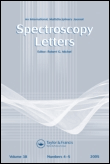
SPECTROSCOPY LETTERS
Your Gateway to Cutting-Edge Spectroscopy ResearchSPECTROSCOPY LETTERS, published by Taylor & Francis Inc, is a pivotal journal that plays a significant role in the fields of Analytical Chemistry, Atomic and Molecular Physics, and Optics. With an ISSN of 0038-7010 and E-ISSN of 1532-2289, it provides a platform for the dissemination of cutting-edge research and developments in spectroscopy and its wide-ranging applications. As of 2023, the journal is ranked in the third quartile (Q3) across its relevant categories, reflecting its importance in these scientific domains. The journal has a continuous publication history from 1968 to 2024, establishing a rich legacy in academic literature. Although it currently does not offer Open Access options, SPECTROSCOPY LETTERS remains a valuable resource for researchers, professionals, and students seeking to advance their knowledge and applications in spectroscopy. For those in the arena of physics and chemistry, this journal is essential for keeping abreast of the latest findings and methodologies in the field.

Journal of the Korean Magnetics Society
Unveiling the science behind magnetic phenomena.Journal of the Korean Magnetics Society, published by the Korean Magnetics Society, is a prestigious academic journal dedicated to advancing the field of magnetics. Renowned for its contributions to both fundamental and applied magnetics research, this journal spans a wide range of topics, including magnetic materials, magnetometry, and applications in technology. Aimed at researchers, professionals, and students, it serves as a vital platform for disseminating high-quality research and innovative findings within the magnetics community. Although it does not currently offer Open Access options, the journal maintains a high academic standard, supported by its commitment to rigorous peer review processes. Its ISSN 1598-5385 and E-ISSN 2233-6648 ensure that it is easily traceable within academic databases, promoting continuous engagement and scholarship in the disciplines of physics and engineering related to magnetic phenomena. Whether you are looking to publish cutting-edge research or stay abreast of the latest discoveries in magnetics, the Journal of the Korean Magnetics Society is an indispensable resource.

JOURNAL OF MAGNETIC RESONANCE
Connecting Science through Magnetic Resonance DiscoveriesThe JOURNAL OF MAGNETIC RESONANCE, a leading peer-reviewed publication from ACADEMIC PRESS INC ELSEVIER SCIENCE, serves as a vital platform for disseminating cutting-edge research in the fields of biochemistry, biophysics, and condensed matter physics. With an ISSN of 1090-7807 and an E-ISSN of 1096-0856, this journal is committed to publishing innovative studies that explore the principles and applications of magnetic resonance techniques. Ranking in the Q3 and Q2 quartiles across various categories in 2023, it reflects a robust standing within the academic community, especially noted for its contributions to nuclear and high energy physics where it ranks 29th out of 87 journals. The journal's comprehensive scope and emphasis on accessible research make it an essential resource for researchers, professionals, and students alike, facilitating advancements in both theoretical and practical aspects of magnetic resonance. With conversion years spanning 1997 to 2024, the journal continues to uphold its legacy as a cornerstone of knowledge in the best practices of scientific research.

MAGNETIC RESONANCE MATERIALS IN PHYSICS BIOLOGY AND MEDICINE
Fostering Collaboration Across Magnetic Resonance DisciplinesMAGNETIC RESONANCE MATERIALS IN PHYSICS BIOLOGY AND MEDICINE, published by SPRINGER, is a premier academic journal dedicated to advancing the fields of biophysics, radiology, and medical imaging. With a strong presence in Germany and an international readership, this journal has established itself as a vital resource for researchers and professionals engaged in the interdisciplinary study of magnetic resonance applications. Featuring a commendable 2023 impact factor and categorized in Q2 quartiles across several domains—including Biophysics and Radiological Technologies—this journal provides a platform for innovative research and practical implementations in the field. Although it does not follow an Open Access model, it offers extensive archives dating back to 1984, affirming its long-standing commitment to scholarly excellence. The journal not only ranks impressively within Scopus metrics, but it also promotes ongoing discourse that bridges gaps between physics, biology, and medicine, making it an essential read for professionals and students aiming to stay informed about cutting-edge developments.
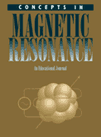
CONCEPTS IN MAGNETIC RESONANCE PART A
Enhancing Understanding of Imaging TechniquesCONCEPTS IN MAGNETIC RESONANCE PART A, an esteemed journal published by Wiley-Hindawi, stands as a pivotal platform in the field of spectroscopy since its inception in 2002. With an Open Access model implemented in 2019, this journal allows for the broad dissemination of research findings, fostering collaboration and innovation among researchers, professionals, and students globally. While it currently holds a quartile ranking of Q4 in Spectroscopy, it aspires to provide a comprehensive collection of original research and review articles that address significant advancements and methodologies in magnetic resonance. Its unique focus invites contributions that enhance understanding and application of imaging techniques, thereby playing a vital role in bridging theoretical concepts to practical applications in chemistry. Boasting an ISSN of 1546-6086 and an E-ISSN of 1552-5023, it continues to encourage the exchange of ideas and data among the scientific community within the United States and beyond, based in the historic Adam House in London.
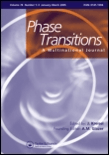
PHASE TRANSITIONS
Advancing Insights into Phase Transition PhenomenaPHASE TRANSITIONS is a prominent academic journal, published by Taylor & Francis Ltd, dedicated to advancing the field of phase transition phenomena across various materials and systems. With a history spanning from 1979 to 2024, this journal provides a vital platform for researchers to share their findings on the intricate behaviors of materials under different conditions, particularly in the domains of Instrumentation and Materials Science. Despite its current Q3 category ranking in both fields, PHASE TRANSITIONS plays a crucial role in pushing the boundaries of these areas, offering insights that contribute to significant innovations. Although it does not operate as an Open Access journal, its content can be accessed through various academic databases, ensuring that important research is available to the community. As reflected by its standing in Scopus rankings, researchers and practitioners alike will find the studies published in this journal to be relevant and impactful in broadening their understanding of material properties and behaviors.

Magnetic Resonance in Medical Sciences
Advancing the Future of Medical ImagingMagnetic Resonance in Medical Sciences is a leading open-access journal published by the Japanese Society of Magnetic Resonance Medicine, dedicated to advancing the field of medical imaging through high-quality research articles and reviews. With a strong focus on radiology, nuclear medicine, and imaging technologies, this journal serves as a crucial platform for the dissemination of innovative studies, as evidenced by its impressive Scopus ranking of #75 in its category and a commendable 77th percentile standing. Since its inception in 2002 and becoming open access in 2016, it has fostered a collaborative research environment, welcoming contributions from both seasoned experts and emerging scholars alike. The journal's commitment to enhancing diagnostic techniques and patient outcomes makes it an invaluable resource for researchers, healthcare professionals, and students passionate about the transformative potential of magnetic resonance imaging. Located in Tokyo, Japan, Magnetic Resonance in Medical Sciences continues to shape the future of medical imaging through rigorous scholarship and impactful research.
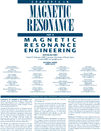
CONCEPTS IN MAGNETIC RESONANCE PART B-MAGNETIC RESONANCE ENGINEERING
Innovating the Future of Imaging and Radiology.CONCEPTS IN MAGNETIC RESONANCE PART B-MAGNETIC RESONANCE ENGINEERING is a premier journal published by WILEY-HINDAWI, dedicated to advancing the field of magnetic resonance engineering. With an ISSN of 1552-5031 and E-ISSN 1552-504X, this journal offers an Open Access platform since 2022, ensuring that research is freely accessible to scholars worldwide. Covering a broad spectrum of applications in medicine, radiology, nuclear medicine, and imaging, it serves as a key resource for professionals looking to stay updated with the latest advancements and innovations in the field. The journal enjoys notable rankings in various categories, including a rank of #137 in Medicine and #26 in Health Professions within Scopus, reflecting its importance and influence in both academic and clinical settings. As a vital conduit for cutting-edge research, CONCEPTS IN MAGNETIC RESONANCE PART B is committed to fostering the growth of knowledge while addressing the critical challenges and technological enhancements within magnetic resonance methodologies. Researchers, professionals, and students can expect to find comprehensive articles that adhere to high scientific standards, promoting discourse and collaboration across disciplines.
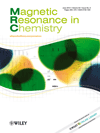
MAGNETIC RESONANCE IN CHEMISTRY
Navigating the Complexities of Magnetic Resonance in ChemistryMAGNETIC RESONANCE IN CHEMISTRY, published by Wiley, is a prominent journal dedicated to the advancement of knowledge in the field of magnetic resonance as applied to chemistry and materials science. With an ISSN of 0749-1581 and an E-ISSN of 1097-458X, this journal has been an essential resource for researchers since its inception in 1985, maintaining its reputation as a leading publication through its converged years up to 2024. Spanning diverse topics, the journal holds a Q2 quartile ranking in both the Chemistry (miscellaneous) and Materials Science (miscellaneous) categories, illustrating its significance in the academic community. With Scopus rankings placing it in the 61st percentile for General Chemistry and the 55th percentile for General Materials Science, this journal is an esteemed platform for original research, reviews, and critical discussions surrounding magnetic resonance methodologies and applications. As access options are not open, it ensures a curated dissemination of high-quality, peer-reviewed content to support professionals, researchers, and students in their scholarly endeavors.
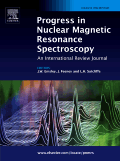
PROGRESS IN NUCLEAR MAGNETIC RESONANCE SPECTROSCOPY
Catalyzing Innovation in Nuclear Magnetic ResonancePROGRESS IN NUCLEAR MAGNETIC RESONANCE SPECTROSCOPY, published by PERGAMON-ELSEVIER SCIENCE LTD, is a premier journal dedicated to advancing the field of Nuclear Magnetic Resonance (NMR) spectroscopy, catering to a wide audience of researchers, professionals, and students engaged in analytical chemistry, biochemistry, materials science, and nuclear physics. With an impressive reputation reflected in multiple Q1 rankings across its relevant categories for 2023, this journal is recognized for its high-quality publications that contribute significantly to the understanding and application of NMR techniques. Although not open access, it remains a vital resource for those seeking to push the boundaries of scientific knowledge and innovation in various disciplines. Published continuously since 1965, this journal not only archives a rich history of NMR research but also presents cutting-edge findings and methodologies, making it an essential reference for anyone involved in this evolving field. The journal’s focus on impactful research, evidenced by its strong Scopus rankings, ensures a scholarly platform where the latest advancements meet the methodological rigor needed for real-world applications.